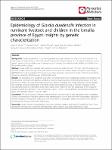Epidemiology of Giardia duodenalis infection in ruminant livestock and children in the Ismailia province of Egypt: insights by genetic characterization
Helmy, Yosra A.
Klotz, Christian
Wilking, Hendrik
Krücken, Jürgen
Nöckler, Karsten
Samson-Himmelstjerna, Georg von
Zessin, Karl-H.
Aebischer, Toni
Background: Giardia duodenalis is a common flagellated protozoan parasite that infects the small intestine of a wide range of vertebrate hosts. This study aimed to determine whether tracing of G. duodenalis isolates by current genetic typing tools is possible using an exemplary set of samples from infected cattle, buffalo and children from the Ismailia province, Egypt. Method: A total of 804 fecal samples from ruminant animals was collected from 191 herds and 165 samples from diarrheal children below the age of 10 years. Parasites were detected in these samples using the copro-antigen RIDA®QUICK test and by real-time PCR. Samples were then genetically characterized based on the triosephosphate isomerase, glutamate dehydrogenase and β-giardin genes. Results: The prevalence of G. duodenalis was 53% in ruminants and 21% in symptomatic children and infection was not positively correlated with diarrheal symptoms. Sequence typing analysis confirmed predominance of B-type sequences (>67%) in humans and E-type sequences (>81%) in ruminants over A-type sequences. For 39 samples the complete sequence information of the three marker gene fragments could be derived. Integration of the concatenated sequence information of the three marker gene fragments with the spatial data of the respective sample revealed that identical or near identical (only up to 1 out of 1358 bp different) concatenated sequencing types were spatially related in 4 out of 5 cases. Conclusion: The risk of zoonotic infection emanating from ruminants even in high prevalence areas is negligible. Genetic characterization indicated a predominant anthropogenic cycle of infection within the pediatric population studied. Integration of sequence typing data with information on geographic origins of samples allows parasite sub-population tracing using current typing tools.
Dateien zu dieser Publikation
Keine Lizenzangabe

